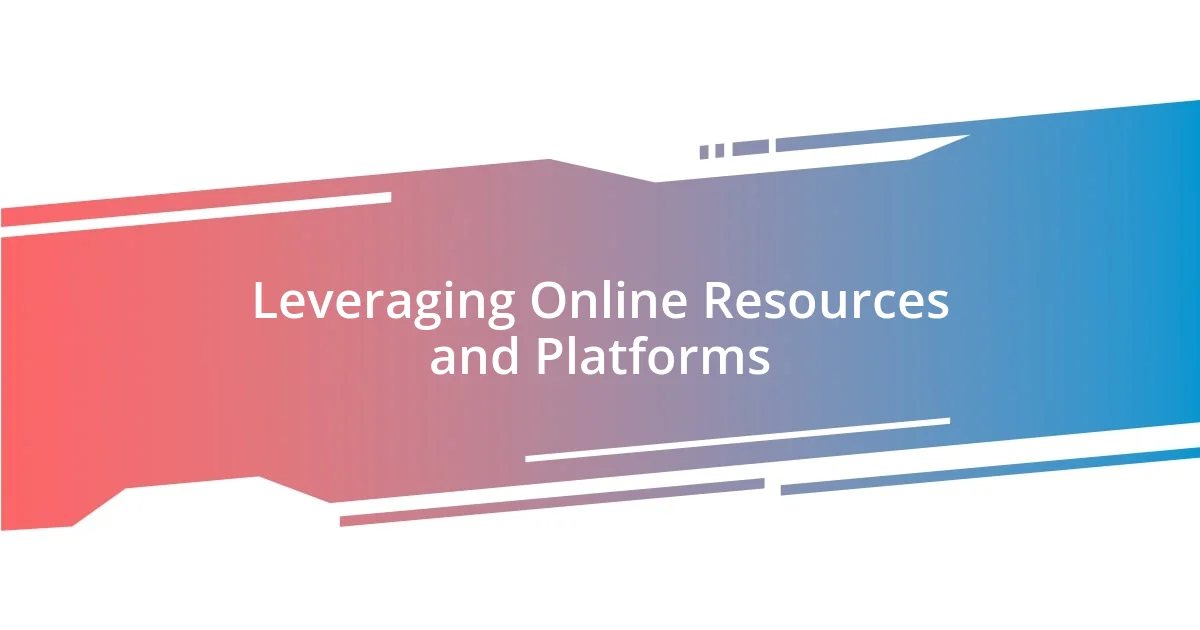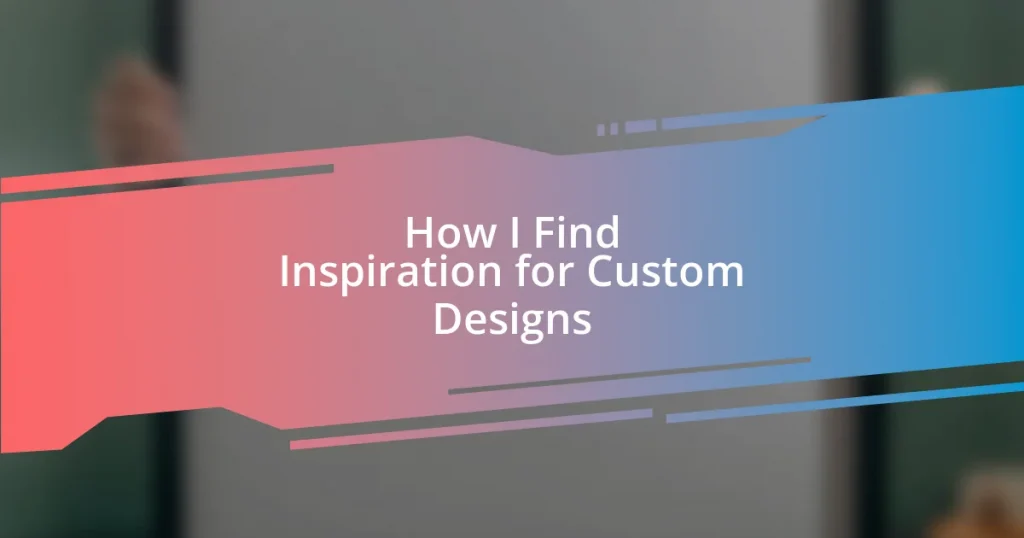Key takeaways:
- Self-reflection and revisiting past inspirations can reignite creativity and lead to innovative designs.
- Exploring diverse design styles and collaborating with other creatives fosters new ideas and enhances the creative process.
- Documenting the design journey through sketches and photographs helps track evolution, influences future projects, and builds a unique design voice.

Understanding Your Creative Process
Understanding your creative process begins with self-reflection. I’ve spent countless hours pondering what truly inspires me. It’s fascinating to consider how something as simple as a walk in nature can spark a brilliant design idea. Have you ever noticed how your surroundings impact your creativity?
I remember a time when I was stuck on a project, feeling like my imagination was on a tight leash. Timely inspiration struck when I decided to revisit childhood sketches I had buried in a drawer. It wasn’t just nostalgia; it was a reminder of the pure joy of creative exploration. How often do we underestimate the power of looking back to move forward?
As I’ve delved deeper into my creative process, I’ve realized the importance of embracing the ebb and flow of inspiration. Some days, ideas flow effortlessly, while others are a struggle. This dichotomy has taught me to be patient and trust the process. Have you found yourself in a similar situation, questioning whether the inspiration will ever come back?

Exploring Different Design Styles
Exploring various design styles opens a doorway to endless possibilities. I’ve personally found that diving into styles like minimalism or bohemian can greatly influence my creative direction. For example, while minimalism emphasizes simplicity, it often leaves room for profound meaning. Have you ever felt that stripping away the excess might lead you to something more authentic?
When I experimented with Art Deco in one of my recent projects, the bold geometry and rich colors transported me back to a glamorous era. It felt like a creative dance, and the patterns inspired emotional connections within my designs. I think it’s powerful how different styles can evoke feelings, don’t you? Each style tells its own story and invites us to explore various narratives through our designs.
I often find that incorporating eclectic elements into my work leads to unexpected yet delightful outcomes. It’s a great reminder that inspiration can stem from blending seemingly unrelated styles. For instance, I once combined rustic charm with sleek modernity in a client’s home office, and the blend created an inviting yet professional vibe. Has any particular design style crossed your path and influenced your work in a surprising way?
| Design Style | Characteristics |
|---|---|
| Minimalism | Focuses on simplicity and functionality, uses neutral colors. |
| Bohemian | Embraces a mix of patterns, vibrant colors, and cultural influences. |
| Art Deco | Features bold geometric shapes and luxurious materials. |
| Eclectic | Blends various styles and elements for a personal touch. |

Utilizing Nature for Design Ideas
Utilizing nature as a source of inspiration can be incredibly transformative. There have been moments when I’ve wandered through a forest and noticed the intricate patterns on tree bark or the delicate symmetry of petals. These details often find their way into my designs, becoming a bridge between nature and creativity. I feel that stepping outside, even just for a few minutes, can open up a world of unique possibilities that might otherwise remain dormant.
Here are some ways nature influences my design ideas:
- Color Schemes: The vibrant hues of a sunset or the subtle shades of a mountain can inspire a palette for a project.
- Textures: The roughness of stones or the softness of moss can inform material choices, adding depth to my designs.
- Forms and Shapes: The organic curves of branches or the geometric symmetry of leaves can lead to innovative structural elements in a piece.
- Patterns: I often take cues from nature’s patterns, like the spiral of a seashell or the repetition in a sunflower, translating these into textiles or wallpapers.
- Biomimicry: Sometimes, I explore how nature solves problems and incorporate those solutions into my designs, making them both beautiful and functional.
By tapping into nature’s inherent designs, I find a wellspring of creativity that feels both refreshing and grounding. It’s like having a conversation with the earth, allowing its beauty to guide my hand.

Leveraging Online Resources and Platforms
When it comes to tapping into online resources, I have a few favorite platforms that fuel my inspiration. For instance, Pinterest is a fantastic visual tool for discovering unique design concepts. I often spend time curating boards filled with striking images that catch my eye, which serve as a guide when brainstorming new projects. Have you ever noticed how a mood board can crystallize your thoughts into clear ideas? That visual representation is truly powerful.
I also enjoy exploring design communities on social media, like Instagram and Behance. These platforms don’t just showcase artwork; they foster connections with other designers and creatives. Recently, I stumbled upon a collaborative project that married art with sustainable design, which sparked a new direction in my own work. The joy of sharing ideas and receiving feedback online can be incredibly motivating, don’t you think?
Additionally, I often dive into design blogs and online courses. These resources provide valuable insights and techniques that I can experiment with in my designs. One article I read on color theory not only expanded my understanding but also led me to incorporate unexpected color combinations in my portfolio. It’s fascinating how the internet can amplify our creative journey, isn’t it?

Collaborating with Fellow Creatives
There’s something truly magical about collaborating with fellow creatives. I remember a time when I teamed up with a photographer for a project, and we spent hours discussing our artistic visions over coffee. It struck me how our different perspectives brought new layers to the designs we created together. Have you ever experienced that “aha” moment when collaboration feels like a dance? It’s invigorating.
What I find particularly rewarding is the exchange of ideas that can occur in these collaborative settings. A conversation with another designer often leads to unexpected insights, like how a simple tweak in a design approach can completely shift the narrative. Just last month, a peer and I swapped sketches, and her minimalist style helped me refine my cluttered designs. It reminded me that creativity thrives in community—it’s not just about personal expression; it’s also about the synergy we create together.
Sometimes, the energy of a group project brings out a spark that you didn’t even know was hidden. I vividly recall brainstorming sessions with a group of artists where we would toss around ideas and doodles. One moment, I suggested an idea based on a dream I had, and that led the group down a creative rabbit hole. Isn’t it remarkable how sharing a space and energy can trigger inspiration? Those collaborative experiences often stay with me, fueling my designs long after the project is over.

Analyzing Successful Custom Designs
Analyzing successful custom designs requires a keen eye for detail. I remember analyzing a clothing line’s collection, focusing on how each piece conveyed a story. It struck me that the successful designs often incorporated a strong thematic element, making them not just clothing but wearable art. Have you ever thought about how emotional connections can elevate a design?
When I dive into the details of a successful design, I like to break it down into its core components—color palettes, shapes, and materials. A standout design I reviewed recently used an unconventional fabric that caught my attention instantly. The richness of texture not only enhanced its visual appeal but also invited touch, literally engaging the audience in a multifaceted way. Isn’t it fascinating how texture can transform a simple piece into something extraordinary?
Finally, I find inspiration in the stories behind successful designs. I once interviewed a local artisan whose custom furniture resonated with me. Their pieces not only featured beautiful craftsmanship but also had narratives woven into the design—like how each cut of wood spoke to the history of the tree it came from. It made me ponder: how often do we overlook the narrative potential in our own designs? Understanding these narratives can undoubtedly shape my approach to creating meaningful custom designs.

Documenting Your Design Journey
Documenting my design journey is like keeping a visual diary; it helps me track the evolution of my ideas. I often sketch my thoughts each day, letting my emotions and experiences influence my designs. Just the other day, I jotted down a concept that emerged from a fleeting moment at a café, where the interplay of natural light and shadows inspired a new pattern. Have you ever had that rush of creativity from a simple scene?
I find that photographs play a pivotal role in documentation, too. Capturing photos of materials, textures, and scenes can ignite sparks of inspiration later on. Recently, I took a picture of an old brick wall with peeling paint, and it reminded me of a potential color scheme for an upcoming project. It’s amazing how an everyday moment can plant the seeds for future designs—do you notice these small details in your surroundings?
Reflecting on this documented journey often leads me to personal revelations about my creative process. I keep a digital folder where I compile everything—from failed attempts to successful designs. One time, revisiting my early sketches helped me realize how much I’ve grown and what I truly enjoy creating. Isn’t it refreshing to witness your own evolution? Not only does it fuel my confidence, but it also guides me toward developing a unique design voice.















